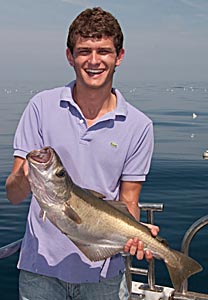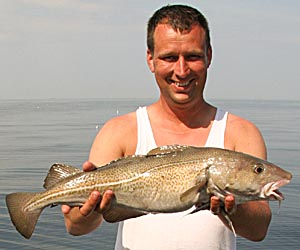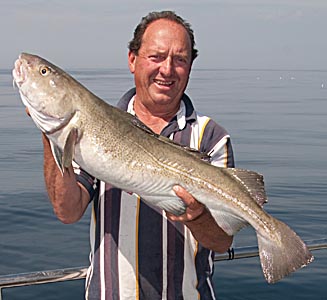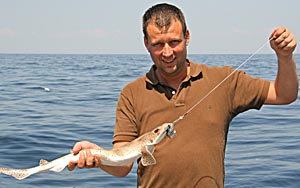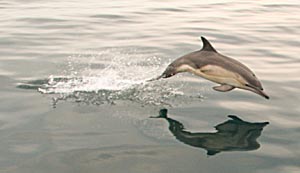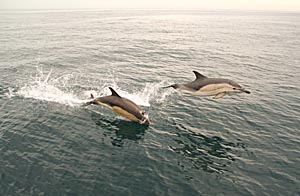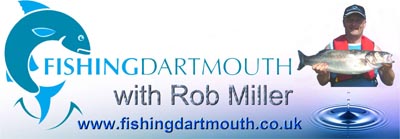 fishing Dartmouth sea angling torbay festival Devon uk charter boat shore plaice turbot bass river dart |
|||||||||||||||||||||||||||||||||||||
BIG CONGER EELS GO DUTCH |
|||||||||||||||||||||||||||||||||||||
|
|
|||||||||||||||||||||||||||||||||||||
|
I recently enjoyed a couple of days afloat fishing for big Eels on the mid-Channel wrecks, with 5 members of the Hoogvliet family, who travelled from their home in Holland, to fish aboard Ian Noble’s Dartmouth charter boat “Samuel Irvin 3”, for hard fighting Congers. This was their second visit to fish for Giant Eels around our local South Devon coastline. They told me they were here several years ago, when “Grandpa”, caught the only solitary Conger of that trip, a fish of 80 lbs while chartering out of Brixham on a different boat. They had fished a well known wreck mark on Monday 1st June, aboard “Samuel Irvin 3” and had caught a number of worthy Eels, but no monsters. I went along on Tuesday 2nd June. After some discussion, Ian and I decided to try a wreck which we had not fished for Eels for the past 18 months or so. We set out at 7.45 am. We stopped a little way from home to catch Mackerel for use as bait. They were scarce and it took us more than 30 minutes to catch 50 or 60 Mackerel on feathers. We recommenced our voyage and steamed for around 2 hours to reach our chosen mid-Channel wreck which lay in 240 feet of water. They were a really interesting group of guys and I found them a pleasure to converse with during our day together. We drank tea, joked, chatted, surmised and reminisced as we prepared our tackle consisting of, 50 lb class rods, fitted with well built quality reels, loaded with braid lines, sliding lead link to attach up to 4 lbs of weight, and 250 lb B.S. mono traces terminating in size 10/0 chemically sharpened hooks. Please do not use a stainless steel hook as it will not rust and drop out, if it is broken off and left in the fish. Knots must be soundly tied for this branch of our sport. Congers are hard fighting and worthy opponents commanding the respect of all who enjoy fishing for them.
On arrival Ian anchored “Samuel Irvin 3” well up-tide of the wreck, so that we could drop back on the anchor rope, to present our baits just short of the wreck. The smell of fresh baits in the water induces the Congers to come out from the wreck to feed as the tide carries the flavour into the wreck. You will rarely catch big Eels by fishing directly into a wreck with your terminal gear, as the Congers will seize your bait and take you straight into the rusting hulk, where they are all but impossible to dislodge. Ian soon spotted on his electronic GPS chart plotter, that despite a heavy anchor, yards of chain and rope, that our boat was being dragged gradually backwards, closer to the wreck by the 4.1 metre tidal flow, driven by a force 2 to 3 breeze from the South East. There was only one thing for it, we lifted our anchor and re-set it even further up-tide. This time it held and our position was perfect. We prepared fresh dead “Mackerel Flapper” baits, by cutting the side fillets to separate them and removing the backbone. This gives the maximum flavour in the water. We mounted our baits through the bottom jaw and out through the top of the snout, to expose plenty of hook. We taped together two 2 lb lead weights into a single combined unit, with a good length of adhesive carpet tape, to ensure our baits were presented tight to the sea bed in the fast flowing running tide. Never clip two leads separately to the same link. They will act like a propeller and spin in the water if you do. Within minutes 21 year old Martyn Hoogvliet felt the gentle pull of a Conger taking his bait. He struck and set his hook and the fight was on. Within a very few minutes a Conger of around 40 lbs was pulled onto the deck of “Samuel Irvin 3”, through the door in the stern, with a little final assistance from Ian Noble, who grasped the hook length. We had made a decision to return all of the Eels alive and in the best condition, to grow and fight again another day, unless there was an obvious record fish. We were reluctant to gaff any of the fish as we wanted them to have the best chance of survival after a quick photograph.
Then his Uncle, Kees Hoogvliet, was into another good Eel, which was lifted aboard for a photo, before being quickly released alive and well..
Not to be outdone, Martyn's brother, Wessel Hoogvliet, caught another excellent Conger.
We all caught Congers throughout the run of the tide. There were plenty of good sized Eels, with the best around 65 lbs, caught by Martyn Hoogvliet.
As this was happening, I caught another Conger of similar size, which was not difficult to bring to the boat on my top quality tackle. I used an Accurate ATD 30 Platinum 2-speed reel in low gear on a 50 lb class Shakespeare Ugly Braid Rod with Aftco roller guides. My main line was Berkley 80 lb braid, with a leader of 60 lb mono terminating in a Bimini Twist loop, to which I attached a “Sampo” Double Solid Welded Ring Ball Bearing Swivel with Stainless Steel Coastlock Snap. My terminal tackle consisted of a metal sliding lead link with a 3½ lb lead weight attached, on 250 lb BS mono. I include a 600 lb “Rosco” barrel swivel in the centre of this trace line, with 1 metre of 250 lb mono below the swivel, to a "Partridge Sea Beast" Chemically Sharpened Size 10/0 hook. All loops are secured with copper double barrel crimps and I fit loop protectors made from plastic covered wire tube, wherever the line passes through swivels or hook eyes. I held my rod in a “Braid Brute Buster” butt pad attached to a big game kidney harness by the same manufacturer. Drop straps from the kidney harness secure the reel when I hook a fish. I fight the big Eels with the muscles in my legs, which is a far easier way of pumping big fish to the boat.
We saw very few really small Eels under 30 lbs throughout the day. The following day, Wednesday 3rd June, we were out together as on the previous day. Ian and I discussed tactics. I have long been of the opinion that if you fish a wreck which holds substantial numbers of Eels, that on the first day, you often catch the average specimens, which greedily seize the baits, before the really big Congers have a chance to find them. On day 2, the smaller Eels you hooked on day 1 are wary and it provides the opportunity for the bigger Eels to find angler’s baits and take the hook. We decided to fish the same wreck as on the previous day, hoping that the theory would prove correct. We hoped that the smaller Eels which had felt a hook might be a little more reticent. Ian positioned and anchored “Samuel Irvin 3” within 5 feet of the position we had commanded the previous day. The breeze was less, at around 2 mph, over a similar tide to the previous day. We had caught Mackerel far more easily today, just outside Dartmouth. We caught enough to last throughout our day in around 10 minutes. For the first 30 minutes, we had 7 baited hooks in the water and nothing happened. The anglers were, I’m certain, wondering if we had spooked the Eels on the previous day, then Martyn Hoogvliet felt a bite and hooked into a good Conger. Within a few moments I had hooked another. Then as I looked around me I saw that there were big fish on 4 of the 7 rods, as I and other anglers pumped and puffed, fighting the Eels. These were all good Congers in the 40 to 60 lb range. So it continued throughout the run of the tide. Wessel Hoogvliet, who is a strong lad of 19 years, hooked into what was clearly a very big Eel. It fought like the leviathan it was. After 30 minutes it was still not in view. Then Wessel declared, “I can see the leader”. A false dawn, as the big Eel dived back down. His Dad, Wim Hoogvliet, poured a bottle of cold water over Wessel’s head, to cool him, as he grunted and strained, which caused much amusement. It took around 45 minutes to bring the Eel to the boat. Ian grasped the 250 lb trace, but the Conger just shook its head and broke the 250 lb Mono trace like cotton. As I watched it spat out a partly digested Crab with a shell around 7 inches across. Then it was gone, but we didn’t mind. Like the big Marlin in hotter parts of the world, we reckoned that as our crew had touched the trace it counted as a catch.
We could undoubtedly have gaffed it and brought it aboard had we chosen to do so, but we consider that an Eel which has been pierced by a gaff has a significantly reduced chance of survival. We were catch and release fishing, not in any competition, where weights are necessarily laboriously checked and recorded, which can result in unwanted dead fish. Ian and I both saw the huge length and girth of Wessel’s Eel as it was brought close to the boat. We had no doubt that, without any exaggeration, it probably weighed between 90 and 100 lbs. Within a very short time, Martyn Hoogvliet hooked another very big Eel, which again took around 45 minutes to bring to the boat. We watched as he battled to pump it up to the surface. Martyn is a 23 year old, well built lad, in excess of 6 feet tall, but the Eel was a strong adversary. Ian pulled this Eel onto the deck of our boat. It was far too big, restless and strong, to weigh then and there. It again had a huge girth and length and was probably between 90 and 100 lbs. After a photograph, it too was unhooked and released alive to fight again another day.
So it continued. Jaap Hoogvliet, the Uncle of the family, caught several good Eels, with the best examples in the realms of 60 lbs plus. Kees Hoogvliet, who was kept busy taking photos between his own fish, caught several Eels to around the same size as Jaap.
The Father of the two young men, Wim Hoogvliet, also caught several good Eels in the same size range. It was an astounding session.
Wessell caught another big Eel, which Ian pulled onto the deck of the boat. He held it aloft for a photograph, with some help from Martyn, while his Dad, Wim, gave a “thumbs up” sign. This was another Conger in excess of 90 lbs.
Later in the day, as the tide started to slow, we were able to reduce the weight needed to hold bottom to around 2 lbs. Martyn caught another big Eel, nowhere as big as the largest Conger he had caught earlier. It took Martyn around 10 to 15 minutes to bring it to the boat. Ian and I estimated it to be around 60 to 65 lbs. Martyn asked if we could weigh it. I think he doubted our judgement and thought we might be exaggerating our estimates of weight. Ian produced a proprietary dial scale from a box in the wheelhouse and made a small hole through the Conger’s lower jaw. We stood Martyn on the bench in the middle of the rear deck, which is more than 2 feet high. Martyn, with help from Ian Noble, who also stood on the bench, lifted the Eel on the scales, while Jaap held Martyn’s leg to make certain he would not fall. The tail of the Eel was still just touching the deck, but it recorded 78 lbs. Our earlier estimates were under that weight, but the right way, with no hint of overstatement. The Eel was photographed and returned alive to the water. I am more than ever certain that our earlier Eels, which had been far larger, and took far longer to play to the boat, were closer to 100 lbs.
I recorded a 10 minute videos of our current day's angling amongst these huge Eels. You will see at first hand the exciting sport we enjoyed on both days and know for certain that there is no embellishment in my fishy tale. As the tide died, the fishing decreased until the big Eels went off the feed. We upped anchor and moved to another wreck where we made four drifts and caught several Cod. Wessel caught a very welcome Pollack.
Kees also caught a Cod for supper.
Ian Noble caught another excellent Cod.
Kees proved that, despite rumours to the contrary, he is only human, when he hooked one of the smallest Lesser Spotted Dogfish I have ever seen.
As we neared Dartmouth, we were greeted by a huge school of perhaps 50 Short Nosed Common Dolphins which ran alongside the boat, jumping through the oxygenated water of our wake and repeatedly crossing under the bows of our big catamaran for 15 minutes or so. I love to see them; they really are very beautiful creatures.
Those rare days when a plan comes together, live long in my memory. If I live to be 100, I may not have the privilege of repeating this experience; it really was exceptional. Thank you chaps and thank
you Ian for such an excellent day. We really must try to do it again before
too long. |
|||||||||||||||||||||||||||||||||||||
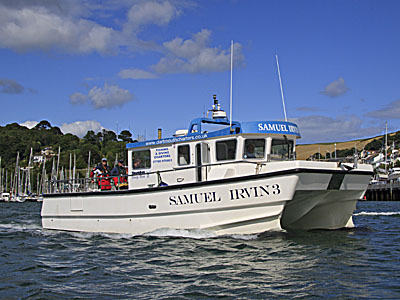
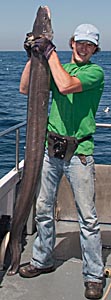
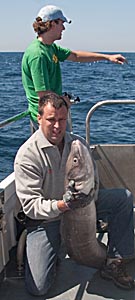
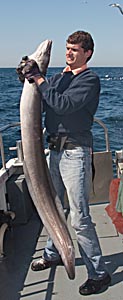
%20020609%20LTRM%20300dpi%20300h%20c%20p%20Sh%20JPEG.jpg)
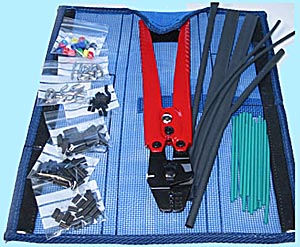


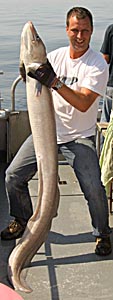
%20%20Conger%20Lift%20030609%20LTRM%20300dpi%20300h%20c%20p%20Sh%20JPEG.jpg)
%20Wessel%20Hoogvliet%20(captor)%20&%20Martyn%20Hoogvliet%20(r)%20Conger%2090+%20Lift%20030609%20LTRM%20300dpi%20300h%20c%20p%20Sh%20JPEG.jpg)
%20Weigh%20Conger%20030609%20LTRM%20300dpi%20300h%20c%20p%20Sh%20JPEG.jpg)
